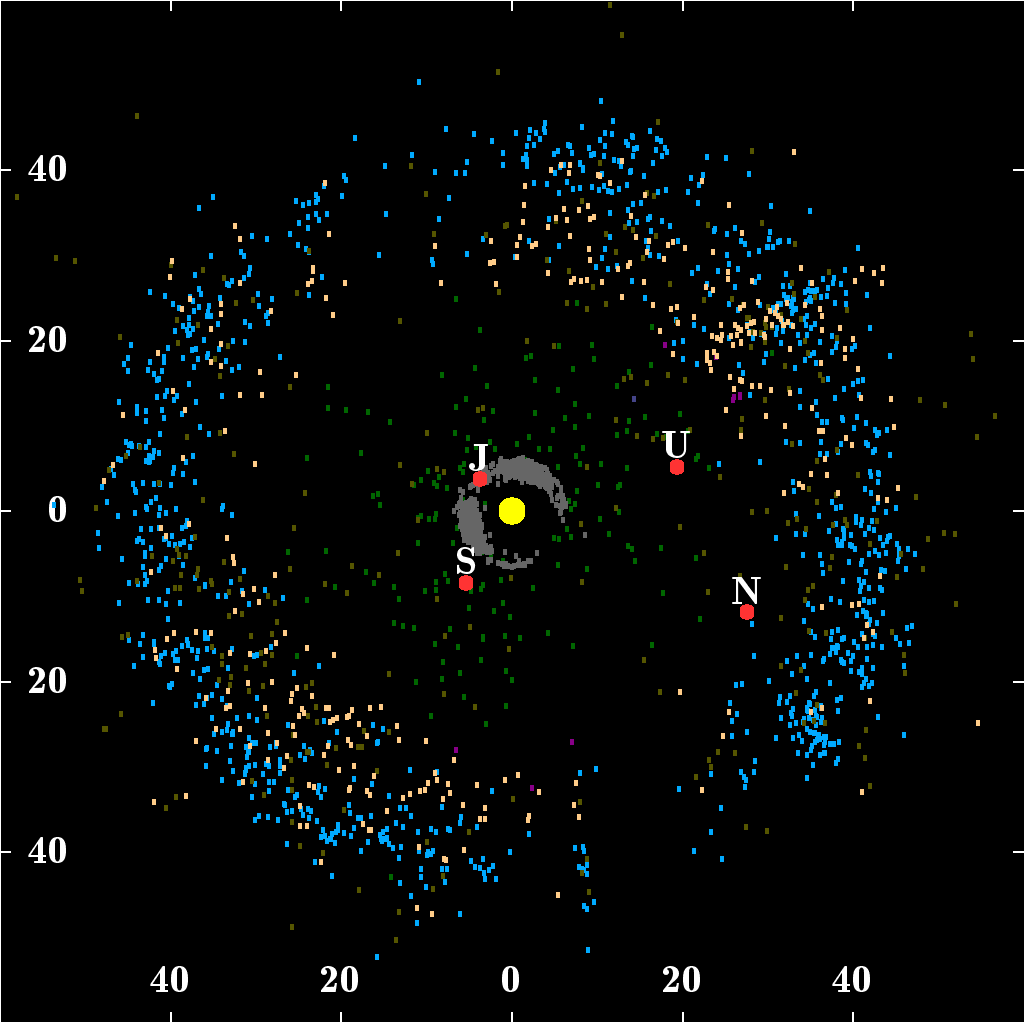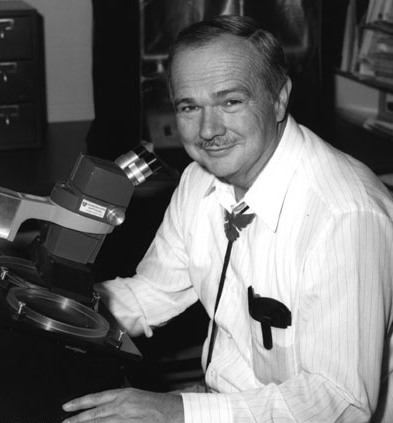|
Triton (moon)
Triton is the largest natural satellite of the planet Neptune, and was the first Neptunian moon to be discovered, on October 10, 1846, by English astronomer William Lassell. It is the only large moon in the Solar System with a retrograde orbit, an orbit in the direction opposite to its planet's rotation. Because of its retrograde orbit and composition similar to Pluto, Triton is thought to have been a dwarf planet, captured from the Kuiper belt. At in diameter, it is the seventh-largest moon in the Solar System, the only satellite of Neptune massive enough to be in hydrostatic equilibrium, the second-largest planetary moon in relation to its primary (after Earth's Moon), and larger than Pluto. Triton is one of the few moons in the Solar System known to be geologically active (the others being Jupiter's Io and Europa, and Saturn's Enceladus and Titan). As a consequence, its surface is relatively young, with few obvious impact craters. Intricate cryovolcanic and tectonic ... [...More Info...] [...Related Items...] OR: [Wikipedia] [Google] [Baidu] |
Triton (mythology)
Triton (; grc-gre, Τρίτων, Trítōn) is a Greek god of the sea, the son of Poseidon and Amphitrite, god and goddess of the sea respectively. Triton lived with his parents in a golden palace on the bottom of the sea. Later he is often depicted as having a conch shell he would blow like a trumpet. Triton is usually represented as a merman, with the upper body of a human and the tailed lower body of a fish. At some time during the Greek and Roman era, Triton(s) became a generic term for a merman (mermen) in art and literature. In English literature, Triton is portrayed as the messenger or herald for the god Poseidon. Triton of Lake Tritonis of ancient Libya is a namesake mythical figure that appeared and aided the Argonauts. Moreover, according to Apollonius Rhodius, he married the Oceanid of said region, Libya. Sea god Triton was the son of Poseidon and Amphitrite according to Hesiod's ''Theogony''. He was the ruler (possessor) of the depths of the sea, who is eith ... [...More Info...] [...Related Items...] OR: [Wikipedia] [Google] [Baidu] |
Kuiper Belt
The Kuiper belt () is a circumstellar disc in the outer Solar System, extending from the orbit of Neptune at 30 astronomical units (AU) to approximately 50 AU from the Sun. It is similar to the asteroid belt, but is far larger—20 times as wide and 20–200 times as massive. Like the asteroid belt, it consists mainly of small bodies or remnants from when the Solar System formed. While many asteroids are composed primarily of rock and metal, most Kuiper belt objects are composed largely of frozen volatiles (termed "ices"), such as methane, ammonia, and water. The Kuiper belt is home to most of the objects that astronomers generally accept as dwarf planets: Orcus, Pluto, Haumea, Quaoar, and Makemake. Some of the Solar System's moons, such as Neptune's Triton and Saturn's Phoebe, may have originated in the region. The Kuiper belt was named after Dutch astronomer Gerard Kuiper, although he did not predict its existence. In 1992, minor planet (15760 ... [...More Info...] [...Related Items...] OR: [Wikipedia] [Google] [Baidu] |
Planetary Core
A planetary core consists of the innermost layers of a planet. Cores may be entirely solid or entirely liquid, or a mixture of solid and liquid layers as is the case in the Earth. In the Solar System, core sizes range from about 20% (the Moon) to 85% of a planet's radius ( Mercury). Gas giants also have cores, though the composition of these are still a matter of debate and range in possible composition from traditional stony/iron, to ice or to fluid metallic hydrogen. Gas giant cores are proportionally much smaller than those of terrestrial planets, though they can be considerably larger than the Earth's nevertheless; Jupiter's is 10–30 times heavier than Earth, and exoplanet HD149026 b may have a core 100 times the mass of the Earth. Planetary cores are challenging to study because they are impossible to reach by drill and there are almost no samples that are definitively from the core. Thus, they are studied via indirect techniques such as seismology, mineral physics, ... [...More Info...] [...Related Items...] OR: [Wikipedia] [Google] [Baidu] |
Mantle (geology)
A mantle is a layer inside a planetary body bounded below by a core and above by a crust. Mantles are made of rock or ices, and are generally the largest and most massive layer of the planetary body. Mantles are characteristic of planetary bodies that have undergone differentiation by density. All terrestrial planets (including Earth), a number of asteroids, and some planetary moons have mantles. Earth's mantle The Earth's mantle is a layer of silicate rock between the crust and the outer core. Its mass of 4.01 × 1024 kg is 67% the mass of the Earth. It has a thickness of making up about 84% of Earth's volume. It is predominantly solid, but in geological time it behaves as a viscous fluid. Partial melting of the mantle at mid-ocean ridges produces oceanic crust, and partial melting of the mantle at subduction zones produces continental crust. Other planetary mantles Mercury has a silicate mantle approximately thick, constituting only 28% ... [...More Info...] [...Related Items...] OR: [Wikipedia] [Google] [Baidu] |
Solid Nitrogen
Solid nitrogen is a number of solid forms of the element nitrogen, first observed in 1884. Solid nitrogen is mainly the subject of academic research, but low-temperature, low-pressure solid nitrogen is a substantial component of bodies in the outer Solar System and high-temperature, high-pressure solid nitrogen is a powerful explosive, with higher energy density than any other non-nuclear material. Generation Karol Olszewski first observed solid nitrogen in 1884, by first liquefying hydrogen with evaporating liquid nitrogen, and then allowing the liquid hydrogen to freeze the nitrogen. By evaporating vapour from the solid nitrogen, Olszewski also generated the extremely low temperature of , at the time a world record. Modern techniques usually take a similar approach: solid nitrogen is normally made in a laboratory by evaporating liquid nitrogen in a vacuum. The solid produced is porous. Occurrence in nature Solid nitrogen forms a large part of the surface of Pluto (whe ... [...More Info...] [...Related Items...] OR: [Wikipedia] [Google] [Baidu] |
Tectonics
Tectonics (; ) are the processes that control the structure and properties of the Earth's crust and its evolution through time. These include the processes of mountain building, the growth and behavior of the strong, old cores of continents known as cratons, and the ways in which the relatively rigid plates that constitute the Earth's outer shell interact with each other. Tectonics also provide a framework for understanding the earthquake and volcanic belts that directly affect much of the global population. Tectonic studies are important as guides for economic geologists searching for fossil fuels and ore deposits of metallic and nonmetallic resources. An understanding of tectonic principles is essential to geomorphologists to explain erosion patterns and other Earth surface features. Main types of tectonic regime Extensional tectonics Extensional tectonics is associated with the stretching and thinning of the crust or the lithosphere. This type of tectonics is ... [...More Info...] [...Related Items...] OR: [Wikipedia] [Google] [Baidu] |
Cryovolcano
A cryovolcano (sometimes informally called an ice volcano) is a type of volcano that erupts volatiles such as water, ammonia or methane into an extremely cold environment that is at or below their freezing point. The process of formation is known as cryovolcanism. Collectively referred to as cryomagma, cryolava or ice-volcanic melt, these substances are usually liquids and can form plumes, but can also be in vapour form. After the eruption, cryomagma is expected to condense to a solid form when exposed to the very low surrounding temperature. Cryovolcanoes may potentially form on icy moons and other objects with abundant water past the Solar System's snow line (such as Pluto). A number of features have been identified as possible cryovolcanoes on Pluto, Titan and Ceres, and a subset of domes on Europa may have cryovolcanic origins. In addition, although they are not known to form volcanoes, ice geysers have been observed on Enceladus and potentially Triton. One potential e ... [...More Info...] [...Related Items...] OR: [Wikipedia] [Google] [Baidu] |
Impact Crater
An impact crater is a circular depression in the surface of a solid astronomical object formed by the hypervelocity impact of a smaller object. In contrast to volcanic craters, which result from explosion or internal collapse, impact craters typically have raised rims and floors that are lower in elevation than the surrounding terrain. Lunar impact craters range from microscopic craters on lunar rocks returned by the Apollo Program and small, simple, bowl-shaped depressions in the lunar regolith to large, complex, multi-ringed impact basins. Meteor Crater is a well-known example of a small impact crater on Earth. Impact craters are the dominant geographic features on many solid Solar System objects including the Moon, Mercury, Callisto, Ganymede and most small moons and asteroids. On other planets and moons that experience more active surface geological processes, such as Earth, Venus, Europa, Io and Titan, visible impact craters are less common because they become ... [...More Info...] [...Related Items...] OR: [Wikipedia] [Google] [Baidu] |
Titan (moon)
Titan is the largest moon of Saturn and the second-largest natural satellite in the Solar System. It is the only moon known to have a dense atmosphere, and is the only known object in space other than Earth on which clear evidence of stable bodies of surface liquid has been found. Titan is one of the seven gravitationally rounded moons in orbit around Saturn, and the second most distant from Saturn of those seven. Frequently described as a planet-like moon, Titan is 50% larger (in diameter) than Earth's Moon and 80% more massive. It is the second-largest moon in the Solar System after Jupiter's moon Ganymede, and is larger than the planet Mercury, but only 40% as massive. Discovered in 1655 by the Dutch astronomer Christiaan Huygens, Titan was the first known moon of Saturn, and the sixth known planetary satellite (after Earth's moon and the four Galilean moons of Jupiter). Titan orbits Saturn at 20 Saturn radii. From Titan's surface, Saturn subtends an arc of 5.09 ... [...More Info...] [...Related Items...] OR: [Wikipedia] [Google] [Baidu] |
Enceladus
Enceladus is the sixth-largest moon of Saturn (19th largest in the Solar System). It is about in diameter, about a tenth of that of Saturn's largest moon, Titan. Enceladus is mostly covered by fresh, clean ice, making it one of the most reflective bodies of the Solar System. Consequently, its surface temperature at noon only reaches , far colder than a light-absorbing body would be. Despite its small size, Enceladus has a wide range of surface features, ranging from old, heavily cratered regions to young, tectonically deformed terrain. Enceladus was discovered on August 28, 1789, by William Herschel, but little was known about it until the two Voyager spacecraft, '' Voyager 1'' and '' Voyager 2'', flew by Saturn in 1980 and 1981. In 2005, the spacecraft '' Cassini'' started multiple close flybys of Enceladus, revealing its surface and environment in greater detail. In particular, ''Cassini'' discovered water-rich plumes venting from the south polar region. Cryovo ... [...More Info...] [...Related Items...] OR: [Wikipedia] [Google] [Baidu] |
Europa (moon)
Europa , or Jupiter II, is the smallest of the four Galilean moons orbiting Jupiter, and the sixth-closest to the planet of all the 80 known moons of Jupiter. It is also the sixth-largest moon in the Solar System. Europa was discovered in 1610 by Galileo Galilei and was named after Europa, the Phoenician mother of King Minos of Crete and lover of Zeus (the Greek equivalent of the Roman god Jupiter). Slightly smaller than Earth's Moon, Europa is primarily made of silicate rock and has a water-ice crust and probably an iron–nickel core. It has a very thin atmosphere, composed primarily of oxygen. Its white- beige surface is striated by light tan cracks and streaks, but craters are relatively few. In addition to Earth-bound telescope observations, Europa has been examined by a succession of space-probe flybys, the first occurring in the early 1970s. In September 2022, the ''Juno'' spacecraft flew within about 200 miles of Europa for a more recent close-up view. Europa ... [...More Info...] [...Related Items...] OR: [Wikipedia] [Google] [Baidu] |
Io (moon)
Io (), or Jupiter I, is the innermost and third-largest of the four Galilean moons of the planet Jupiter. Slightly larger than Earth’s moon, Io is the fourth-largest moon in the Solar System, has the highest density of any moon, the strongest surface gravity of any moon, and the lowest amount of water (by atomic ratio) of any known astronomical object in the Solar System. It was discovered in 1610 by Galileo Galilei and was named after the mythological character Io, a priestess of Hera who became one of Zeus's lovers. With over 400 active volcanoes, Io is the most geologically active object in the Solar System. This extreme geologic activity is the result of tidal heating from friction generated within Io's interior as it is pulled between Jupiter and the other Galilean moons— Europa, Ganymede and Callisto. Several volcanoes produce plumes of sulfur and sulfur dioxide that climb as high as above the surface. Io's surface is also dotted with more than 100 mountains ... [...More Info...] [...Related Items...] OR: [Wikipedia] [Google] [Baidu] |




.png)





